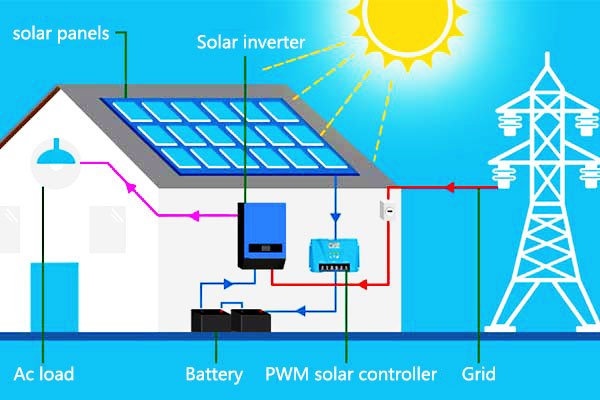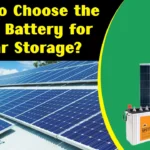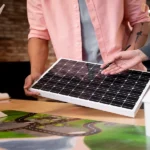When you think of solar power, you likely imagine solar panels. But the real heart of any solar energy setup is the solar inverter. This small device plays a big role. It converts electricity, manages your solar system, ensures safety, and even tracks performance.
In this article, we explain the importance of inverters in solar energy systems, especially in the Indian context.
What Does a Solar Inverter Do?
Solar panels capture sunlight and turn it into direct current (DC) electricity. But your home and the grid use alternating current (AC) power. A solar inverter converts this DC into usable AC power. This process is called DC to AC conversion.
Without the inverter, your appliances can’t use the power your solar panels generate.
Key Functions of a Solar Inverter

1. DC to AC Conversion
This is the basic job of any inverter. It makes electricity usable for homes, businesses, or factories. Without this conversion, the energy remains trapped in a form that cannot power anything.
2. Maximizing Solar Power Output
Modern inverters use Maximum Power Point Tracking (MPPT) technology. This helps your system get the most power from your solar panels. MPPT adjusts the voltage and current to match changing sunlight, shadows, or temperature. It helps improve system performance and efficiency.
3. Grid Synchronization
In grid-tied solar systems, the inverter matches the grid’s voltage and frequency. During a power cut, the inverter automatically shuts off. This protects utility workers from accidents. This safety feature is called anti-islanding protection and is required by law.
4. Monitoring and Alerts
Most inverters have digital screens or app connectivity. They show daily energy generation, faults, or problems in the system. This helps in quick maintenance and better decision-making. Some advanced inverters even offer Wi-Fi monitoring and remote access.
Also Read Rooftop vs Ground-Mount Solar
Types of Solar Inverters in India
There are many inverter types used in Indian homes and businesses. Let’s look at the most common ones.
1. String Inverters
- Most popular in homes and small businesses
- Panels are connected in a series or “string”
- Cost-effective and simple
- One issue in one panel can affect the whole system
2. Microinverters
- Installed on each solar panel
- Each panel works independently
- Best for rooftops with shading or different directions
- More expensive but offers better performance and monitoring
3. Power Optimizers
- Installed under each panel
- Work with a central string inverter
- Improve panel performance
- Cheaper than microinverters but more efficient than basic string systems
4. Hybrid Inverters
- Combine solar panel output with battery storage
- Useful for areas with frequent power cuts
- Can manage solar, battery, and grid power
- Becoming popular in Indian households looking for energy independence
5. Off-Grid Inverters
- Used in remote areas with no access to the electricity grid
- Work with batteries to store solar power
- Essential in rural India or for farms, schools, and clinics
How Inverters Help with Net Metering
India supports net metering policies in many states. This allows homeowners to send extra electricity back to the grid and earn credits.
The inverter is key to this process. It not only converts power but also measures how much energy goes in and out. With net metering, you can save thousands of rupees each year on your electricity bill.
Things to Consider Before Choosing a Solar Inverter
1. Efficiency
Look for an inverter with at least 95% efficiency. Higher efficiency means more usable power from your system.
2. Warranty
Inverters usually come with 5 to 10 years of warranty. Good brands offer extended warranties, which are useful since inverters usually last less than panels.
3. Brand Reputation
Choose a certified solar inverter brand. Check if they are approved by MNRE (Ministry of New and Renewable Energy) or other government bodies.
4. System Compatibility
Not all inverters work with all solar panels or batteries. Make sure your inverter matches your system design and future expansion plans.
5. Price vs. Performance
Inverters come in various price ranges. Don’t always go for the cheapest. Consider performance, reliability, and after-sales support too.
Why the Inverter Is So Important in Indian Conditions
- Indian rooftops face dust, heat, and monsoon rains
- Inverters are sensitive to temperature and moisture
- Install the inverter in a cool, dry, and shaded area
- Proper installation and maintenance can extend its life
In areas with frequent voltage fluctuation, choose an inverter with over-voltage and short-circuit protection.
Common Myths About Solar Inverters
Myth 1: All inverters are the same
Fact: There are big differences in types, quality, and features.
Myth 2: Inverters don’t need maintenance
Fact: Dust, heat, or voltage surges can damage them. Clean and monitor regularly.
Myth 3: Inverter failures are rare
Fact: Inverters often fail before solar panels. It’s the most replaced part in a solar system.
FAQs: Solar Inverters in India
Q1. Can I install solar panels without an inverter?
No. Without an inverter, you can’t use the electricity produced.
Q2. Which inverter is best for Indian homes?
String inverters are cost-effective. Use microinverters or hybrid models if you have shading or plan to use batteries.
Q3. How much does a solar inverter cost in India?
A basic 3kW string inverter may cost ₹20,000–₹30,000. Hybrid or microinverters are more expensive.
Q4. How long does an inverter last?
Typically 8 to 12 years. Some high-end inverters last up to 15 years with good care.
Q5. What happens during a power cut?
Grid-tied inverters shut down for safety. Use a hybrid or off-grid inverter with batteries to maintain power.
Conclusion
Your solar inverter is more than a simple box. It is the brain of your solar power system. It handles the conversion, safety, monitoring, and efficiency of the system. In India, where power conditions and weather vary, choosing the right inverter is vital.
Whether you are planning a rooftop setup for your home or a commercial solar plant, make sure the inverter you choose fits your needs. A reliable, efficient, and well-installed inverter can make your solar journey smooth, powerful, and long-lasting.
Let your solar system work smart—not just hard.










